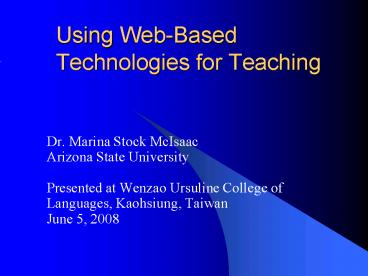Using Web-Based Technologies for Teaching - PowerPoint PPT Presentation
1 / 27
Title:
Using Web-Based Technologies for Teaching
Description:
virtual worlds and serious games' Shift in teaching. Facilitate independent learning ... Virtual learning spaces... 2nd Life. Educational Potential. E-mail ... – PowerPoint PPT presentation
Number of Views:23
Avg rating:3.0/5.0
Title: Using Web-Based Technologies for Teaching
1
Using Web-Based Technologies for Teaching
- Dr. Marina Stock McIsaac
- Arizona State University
- Presented at Wenzao Ursuline College of
- Languages, Kaohsiung, Taiwan
- June 5, 2008
2
Alphabet of Learning
- b-learning, blended
- e-learning, electronic
- m-learning, mobile
- u-learning, ubiquitous
3
Change in Pedagogy
- learning styles of the net generation
- implications of convergence of technologies
- formal vs. informal learning
- collective intelligence, collaborative learning
- virtual worlds and serious games
4
Shift in teaching
- Facilitate independent learning
- Integrate learning tools into instruction
- Synthesize and communicate concepts
- Teach students to gather information
- Demonstrate best technology practices
- Collaborate in knowledge networks
5
Pedagogy and technology integration
S
social cultural interactive
distributed situated
ICT
Web2 knowledge construction
CoP scaffolded
6
Learning is social and interactive
S
social cultural interactive
distributed situated
ICT
Web2 knowledge construction
CoP scaffolded
7
Social Constructivism
- Cultural mediation (Vygotsky) Any higher
mental function was social at some point before
becoming truly mental - Social presence (Short et al.) The degree to
which people feel connected to each other...... - Interaction (Moore, Muirhead) ...between
learners, learner-teacher, learner-content,
learner-interface...
8
Learning is distributed and situated
S
social cultural interactive
distributed situated
ICT
Web2 knowledge construction
CoP scaffolded
9
Distributed Cognition
people think in conjunction and partnership
with others and with the help of culturally
provided tools and implements (Salomon, 1993,
p. xiii).
10
Situated Learning
Situated cognition has emerged as a powerful
perspective in providing meaningful learning and
promoting the transfer of knowledge to real-life
situations.
Choi Hannafin
11
Learning-Communities of Practice
S
social cultural interactive
distributed situated
ICT
Web2 knowledge construction
CoP scaffolded
12
Communities of Learning
- CSCL-Computer-supported communities of learning
- Networked CoP (communities of practice)
- Scaffolding
13
Dimensions of Learning
S
social cultural interactive
distributed situated
ICT
Web2.0 knowledge construction
CoP scaffolded
14
Pedagogy and Web 2.0
- Collective intelligence
- User generated software
- Social construction
- Reflective environment for conscious thought
15
Why ICTs?
- Student centered learning pedagogies
- Informal learning
- External influences
- Technology in the workplace
16
Web2.0 Environments
- Open Source software (OSS)...
- Knowledge construction...Tappedin
- User generated content...Wikis
- Reflection of conscious thought...Blogs
- Student centered learning...Podcasts
- Virtual learning spaces... 2nd Life
17
18
Educational Potential
- E-mail (communication)
- Blogs (dynamic communication, recent info)
- Moodle(socially constructed knowledge)
- Blackboard (discussion, assignments)
- Wikis (collaboration, feedback, assessment)
19
Most popular
- MySpace (connect with others, blog, music)
- Facebook (social utility)
- You Tube (video sharing)
- Second Life (3 D learning environment)
20
Yack Pack
- Yack-Pack allows multiple asynchronous
opportunities for collaboration using voice and
text.
O.Benavides
21
Internet Telephony
- Students use Skype to work on group projects
establishing teleconferences.
22
Tappedin
- Students collaborate on group projects and share
resources
O.Benavides
23
Desktop videoconference
- Deborah Lowther speaks to Technology Integration
Class
O.Benavides
24
The use of blogs enables students and teachers to
post information on a secure site for discussion
and collaboration outside of the classroom.
O.Benavides
25
Develop a web-based activity
- Select a lesson you would like to teach
- What is one new activity you could do using
technology? - How would this help your lesson?
- What do you need for the project?
26
Hsieh Hsieh McIsaac_at_asu.edu
27
(No Transcript)































